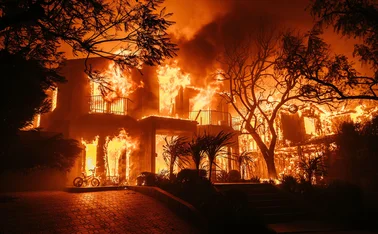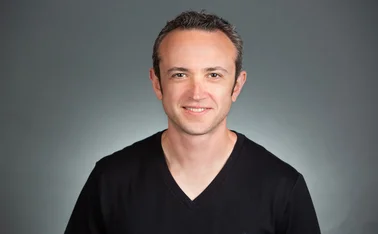
Interview: Dany Cotton, London Fire Brigade

Need to know
- Joined force in 1988 and when she was assigned to her first watch three men threatened to resign
- Thinks insurers have a role to play in incentivising clients to introduce sprinklers and carry out risk assessments
- Urges insurance industry to take action over recycling plants not complying with regulation
- Shares concern over arson and fraud
As director of safety and assurance at the LFB, Dany Cotton talks to Stephanie Denton about diversity, technological advances and what insurers can do to help prevent fire loss
The insurance sector is presently marking the 350th anniversary of the Great Fire of London, when flames raged through the capital's streets, ultimately giving birth to the industry that employs many of Post's readers today.
 Some 200 years later and the escalating compensation costs became too high for insurers to handle. After they informed the government they were unwilling to be responsible for London’s fire protection, their younger relative, the Metropolitan Fire Brigade, was formed in 1866. Captain Sir Eyre Massey Shaw became the chief officer of the MFB and established a rank system, introduced uniforms, built new fire stations and brought in steam fire engines – and this is where today’s London Fire Brigade has its own roots.
Some 200 years later and the escalating compensation costs became too high for insurers to handle. After they informed the government they were unwilling to be responsible for London’s fire protection, their younger relative, the Metropolitan Fire Brigade, was formed in 1866. Captain Sir Eyre Massey Shaw became the chief officer of the MFB and established a rank system, introduced uniforms, built new fire stations and brought in steam fire engines – and this is where today’s London Fire Brigade has its own roots.
“With the Great Fire of London, people just were all for themselves and wanted to run out, save their own things,” explains the LFB’s director of safety and assurance Dany Cotton. “It was just buckets and people throwing water, if you were lucky.”
From that grew the modern service, which – like insurance – has its roots in the ashes of the 1666 fire. “Almost everything has changed since then, from the way buildings are built and fire suppression systems to the firefighters and their equipment,” Cotton explains.
“Looking out the window today, you can see any number of large-scale developments taking place across London. They will all have dedicated fire prevention systems built in, and those are more complex than those running a spaceship sometimes. The Shard is a fantastic example of a fire-engineered building. It has a room that is just dedicated to the fire suppression, prevention and smoke control. So the chance of fire breaking out is far lower. And if it does break out, the spread risk is far lower.”
In addition Cotton explains firefighters are well trained today: “Our staff are so much better equipped, trained, prepared. They know the risks on their own ground. When they turn up, they know where to find water, where to park, how to plug into dry rising mains. The equipment we use is also evolving the whole time. Our firefighting equipment means we can go into fires that are much hotter than we used to be able to, protected.”
Cotton’s own 28 years in service have also seen significant change. “When I joined, a car was a car, and you could cut anywhere and it made no difference. Now you have to get a map and a drawing design so that you don’t go through one of the systems that supplies airbags for instance. Now vehicles are made from different metals and we’ve had to develop new cutting equipment to be able to specifically use on certain types of cars.”
 Other technology advances have also been made which aid the fire service. “We have thermal imaging cameras, which will detect heat through walls. They can provide a video link out to the command unit so the incident commander can see inside the fire. There’s also a specific type of lance that actually injects water into a wall and bores through it. You can put it in through a brick wall from the outside and spray a room to reduce the heat there to make the compartment more bearable for our firefighters to go in.”
Other technology advances have also been made which aid the fire service. “We have thermal imaging cameras, which will detect heat through walls. They can provide a video link out to the command unit so the incident commander can see inside the fire. There’s also a specific type of lance that actually injects water into a wall and bores through it. You can put it in through a brick wall from the outside and spray a room to reduce the heat there to make the compartment more bearable for our firefighters to go in.”
And the future is also bringing drones: "Being able to fly a drone means you could get a much better aerial view. Also if you’ve got a building that’s boarded up, and you think there might be people in there, drones with a thermal imaging camera can run up and down outside the building.”
It’s not just the equipment that has changed during her service. “We now have the ability to assist other rescue services and have supplied firefighters to a number of different areas with large-scale flooding. Our high-volume pumps have the capacity to pump large quantities of water across a large distance.
“In addition we do lots of work in preparation and planning for events to happen. We regularly exercise with the London boroughs and with our own internal teams to plan for disasters. That can be from terrorism at one end, to natural disasters like flooding at the other. It’s no longer about just the fire service or the blue light response. It’s about the whole collaborative piece with the community as well.”
Joining the service
Cotton joined the fire service in 1988 straight out of college: “I saw an advert that said that the LFB was recruiting and positively welcoming applications from women and people from black and minority ethnic groups.”
Eighteen months later and after an intensive 17 weeks of training on the technicalities of equipment, the history of firefighting and some tough physical training, Cotton started her first post as a firefighter at Wimbledon Fire Station, as one of only 30 women out of 6000 firefighters in the overall force.
“I hadn’t appreciated, up to that point, that there would be a barrier to women being in the fire service. It was just something I wanted to do,” she says. “When I first got posted, there were no other women on the station. It was just me. Although there were women’s toilets, there were no separate showers, and I shared a dormitory and locker room. I changed with men and I slept alongside them.”
And the men weren’t too keen on having her there: “They’d not worked with women on the watch. Three of them put in a transfer request before I got there, because they didn’t want to work with a woman. Others were overly helpful because I was a young girl and they wanted to do everything for me. That was almost as bad as having people who didn’t speak to me.
“My first governor was old-school and said to me when I arrived: ‘I don’t agree with women in the fire service. I didn’t want you on my watch. However, if you perform as well as the other recruits, keep your mouth closed, your ears open, your head down and study, then I’m sure you’ll be fine.’”
But she was pleased to be able to change his mind: “I met him some years later and he said actually it was really great. He was the one who stopped people transferring. So although three of them put into transfer, he said: ‘No, stay it out three months, and if you’ve still got the same view, I’ll review your transfer request.’ But none of them transferred.”
 After seven years as a firefighter, Cotton went for her first rank promotion as leading firefighter and has since gone on to become one of the highest ranking female firefighters in Europe. In January 2004, she was awarded the Queen’s Fire Service medal and in 2011, she was voted among the most influential women in London.
After seven years as a firefighter, Cotton went for her first rank promotion as leading firefighter and has since gone on to become one of the highest ranking female firefighters in Europe. In January 2004, she was awarded the Queen’s Fire Service medal and in 2011, she was voted among the most influential women in London.
Along the way, Cotton helped to set up a mentoring scheme for young women who want to join the fire service. And diversity is improving, with women in the service now numbering 330 out of about 5000.
“The other thing that has changed is the role of a firefighter,” she adds. “The balance between time doing frontline operational duties compared to the amount of time we spend preventing fire has changed hugely. Our role is far more about educating the community and about helping businesses. So now, we spend far more time preventing the fires than we do putting them out."
National advertising on smoke alarms has seen some success with people testing them more regularly as has the development of sealed smoke alarms where it's impossible to remove the battery. But the force is now making a massive push on sprinklers something the Association of British Insurers is also campaigning for.
“We’ve been pushing for a very long time for sprinklers in buildings. We absolutely recognise the benefit, and it’s not just about commercial premises. It’s about putting them in vulnerable premises: care homes, places where individuals who’ve got vulnerable sets of circumstances live, schools and commercial premises.
“As part of a new build, they should be putting in a sprinkler because it makes the outcome so much better in the event of a fire. Insurers have a role to encourage businesses to respond in the right way. If companies were given incentives, used properly accredited companies, and got a reduction in their insurance, that would really make a difference for us. Where there is the possibility of proactive prevention, insurance companies should be at the forefront.”
Rewarding companies
Cotton would also encourage insurers to provide incentives to commercial policyholders that take fire safety seriously. “Commercial premises now have to carry out a fire risk assessment when they employ five or more people. We carry out 15,000 inspections every year in London, mainly in commercial premises, to see if they comply with the law. We could use that to assist insurance companies. It would be really useful if insurers could reward those that choose a fire risk assessor from an approved list. Too many people who do fire risk assessments are not complying with the standards.”
And she doesn’t think this should stop at commercial properties either, adding: “We do home fire safety visits, including 90,000 in London alone, and have wondered if there was any way of the insurance industry helping to evaluate the success of this. And if there was, whether policyholders could get a reduction in their premiums.”
Cotton is also keen to set the record straight on firefighters attending commercial blazes. “I am the head of safety and assurance. It’s in my title. My job is to make sure our firefighters go to work, do the best professional job they can do, and come home at the end of the day.
“One of the key things we do is save property. We would never actively seek to stand outside a building and not do anything. What we won’t do though, if we recognise in the design and manufacture that there is a risk to life, is send firefighters in there. What we’ll do is go into the next sets of warehouses either side, put in prevention measures to stop it spreading, take out any hazardous things like cylinders. If there are people in there, we will always commit to going into the building.”
And the force is also keen to help insurers over the very serious matters of arson and fraud. “We have an incredibly good fire investigation team in-house that examine every single fire we don’t know the cause of [immediately]. It has about a 99% success rate. The team will spend days and days sifting through everything and they’ll get to the point where they can determine what started it.
“In London, we’ve got a combination of highly-trained fire investigators assisted by our four-legged friends, the arson-detection dogs.”
Cotton adds: “Our watches are very vigilant to understanding how fires start and how they spread. They are very good at calling the fire investigators, who automatically come to any fire of four pumps and above to investigate.”
She believes the LFB has a “good relationship” with insurers but feels it could be better. Two areas where Cotton would like to work closer with insurers are product recall and recycling plant fires.
“We’re running a campaign at the moment called Total Recall, which aims to make it easier for people to protect themselves from potentially lethal faulty appliances.”
With nearly one fire a day in London involving white goods, the LFB's campaign is calling for the development of a single government-backed and national recognised recall register so people can easily check their appliances.
With recent recalls including Vauxhall Zafiras catching fire and washing machines and tumble dryers causing fires across London, Cotton adds: “Our fire investigators are very good at getting together detailed analyses and looking for trends and patterns, and then going back to manufacturers and saying: ‘We think you’ve got a problem’. But then there is a sticking point about that actually becoming public. Insurance companies should be on side with that, as they’re the ones that end up paying up if products are not correctly recalled. A joined-up piece of work around the prevention side, and being more proactive would be beneficial.”
 Her other personal bugbear is recycling fires. "I was the incident commander for a 40-pump fire, which is the largest fire we've had in London since 1972. It was the day of the Olympic closing ceremony in 2012, seven miles from the site and it went on for 16 days. It was a waste recycling plant, which made baled waste to burn in power plants. And it burns at high heat for a long time. But the price of waste had gone down so they’d stockpiled it. There was around three times the amount that should have been in the warehouse.”
Her other personal bugbear is recycling fires. "I was the incident commander for a 40-pump fire, which is the largest fire we've had in London since 1972. It was the day of the Olympic closing ceremony in 2012, seven miles from the site and it went on for 16 days. It was a waste recycling plant, which made baled waste to burn in power plants. And it burns at high heat for a long time. But the price of waste had gone down so they’d stockpiled it. There was around three times the amount that should have been in the warehouse.”
She urges insurers to take action in this area: “Ensure [waste recycling plants] are complying with the regulations, because most of them aren’t. There are specific designs and regulations they should comply with. Initially you might agree to insure a site, and you go and inspect it and it looks like it should look. But in six months’ time, it is a different story.”
Room at the top?
Cotton is due to leave the service in the next four years but with the London Fire Commissioner Ron Dobson leaving at the end of 2016 there is still time for her to make it all the way to the top. Although she’s keeping quiet over whether she plans to apply for the position, it’s clear with her passion for the brigade she’s sure to spend at least some of her remaining time bringing in new recruits.
“If you are interested in your community, want to make a real difference, are a team player, and physically fit, there’s no better job in the world.
“If you go home at the end of the day knowing you have saved somebody’s life – by fitting a smoke alarm which has alerted them, or by teaching a young child how to help their family escape in the event of a fire – you can’t get a better feeling than that. I genuinely feel this job has put me in a privileged position to be able to say that. And it’s just the best feeling in the world.”
Only users who have a paid subscription or are part of a corporate subscription are able to print or copy content.
To access these options, along with all other subscription benefits, please contact info@postonline.co.uk or view our subscription options here: http://subscriptions.postonline.co.uk/subscribe
You are currently unable to print this content. Please contact info@postonline.co.uk to find out more.
You are currently unable to copy this content. Please contact info@postonline.co.uk to find out more.
Copyright Infopro Digital Limited. All rights reserved.
As outlined in our terms and conditions, https://www.infopro-digital.com/terms-and-conditions/subscriptions/ (point 2.4), printing is limited to a single copy.
If you would like to purchase additional rights please email info@postonline.co.uk
Copyright Infopro Digital Limited. All rights reserved.
You may share this content using our article tools. As outlined in our terms and conditions, https://www.infopro-digital.com/terms-and-conditions/subscriptions/ (clause 2.4), an Authorised User may only make one copy of the materials for their own personal use. You must also comply with the restrictions in clause 2.5.
If you would like to purchase additional rights please email info@postonline.co.uk








